Pre-departure
Friday, Jan. 29, 2016
NAIT, Edmonton
As baking program chair and instructor Alan Dumonceaux (Cook '84, Baker '87) heads to Paris to compete in the most prestigious baking contest in the world, he packs one of his most critical items - allergy medication.
In an all-too-common culinary irony, Dumonceaux is a baker allergic to flour. In the practices during the months leading up to Coupe du Monde de la Boulangerie, or the Bakery World Cup, he has battled itchy eyes, a stuffy nose and breathing difficulties brought on by long-term exposure to flour. But there was too much at stake to let an inconvenient reaction to ground wheat stand in his way.
Dumonceaux and his Baking Team Canada teammates James Holehouse (Baker '00), a fellow instructor, and Marcus Mariathas, director of product development at Toronto's Ace Bakery, achieved a first for Canada last spring by qualifying with 11 other teams for the event. Held every four years in France, the Bakery World Cup puts the world's best bakers through a gruelling test of stamina and skills.
When the competition begins in a little more than a week in a convention centre in the suburbs of Paris, the three men will have 10 hours over two days to create a wide array of baked goods, everything from baguettes to brioche to sandwiches and bread sculptures, all to exacting specifications. It will be their sole chance to prove themselves and represent the country - bakers can only compete once in the team event.
Just making the cut - and sharing the international stage in France, a country where the ingredients and preparation of bread are regulated by law - could be considered the height of accomplishment in any baker's career. Unless you think like Dumonceaux.
"We're the first Canadian team to make it to the World Cup. No one can ever take that away from us," he says. "But our goal now is to win - that's the standard we set for ourselves. If we're not going with the intent to win, why are we going?"
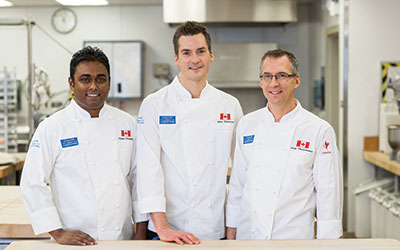 The last practice
The last practice
Sunday, Jan. 31
Lesaffre Baking Centre, Lille, France
In preparation for the feb. 5 - 9 competition, the team arrives in Lille, about two hours north of Paris, and sets up in a practice kitchen at the Lesaffre baking centre.
The Taiwanese and Japanese teams are in adjacent kitchens. A documentary film crew follows the Japanese team members, who have been practising six days a week for six months.
The Canadians have been practicing for months as well. Holehouse cancelled a Christmas trip to Mexico to visit his sister; Dumonceaux gave up time with his family over the holidays; Mariathas and coach Mario Fortin, an international baking consultant from Montreal, spent weekends flying to Edmonton to practice in NAIT's kitchens.
This, however, is different. Now in France, they must get used to new equipment, such as the ovens, and the ingredients. French flour and butter, unavailable in Canada, are considerably different than what's back home and will mean adjustments to recipes and techniques.
Nevertheless, Clayton Folkers (Cooking '79) is optimistic. "I think our chances are really good," says the team technical adviser. "It all boils down to what you do on the day of competition. The question is, do we rise to the occasion?"
That might be trickier than expected. Mariathas, the team's baguette expert, discovers the temperature on the retarder (the refrigerator that controls yeast fermentation) fluctuates. When he mixes his bread starter with two others he's created here for his baguette dough, the retarder kills the yeast.
Like other bakers, Mariathas brought his own, transporting it in layered freezer bags tucked among his clothes. Unlike the other bakers, he was told by the French judge at the qualifying competition in Argentina that his baguette was the best he'd ever tasted.That starter - 200 grams of goop made of flour and water in which wild yeast grows - is precious, providing the buttery, sweet flavour of the baguette, which is made with only the starter, flour, water, salt and fresh yeast.
Luckily, he lost only a small amount of starter.
For Holehouse, responsible for the team's bread sculpture, the practice in Lille is more about mental preparation and organizing his ingredients. For the previous two weeks, he ran through the entire 10-hour baking and assembly of his showpiece four times.
"It's just so overwhelming now that this is the top competition in the world, and I don't want to be unprepared," he says. Holehouse, who has worked at the Shaw Conference Centre and overseen the pastry kitchen at the Grand Hyatt in Taipei, has worked with chocolate and sugar in the past, but has sculpted bread only once before in competition.
"Bread is much more fragile," he says. "The pieces contract and warp as they bake so you don't have as much control." The pieces are held together with sugar syrup, which doesn't stick as well to bread as it does to other sugars.
In Argentina, Holehouse finished his sculpture with four minutes to spare. "It's going to be even harder in Paris," he says.
Fortin, who has served as a judge at the last two Coupe du Monde competitions, would agree. "I would say 10 of the 12 teams competing have the potential to make it to the podium," he says "I think the team that misses just one product will be out; it will be that close. It's the details that matter and, sometimes, those aren't easy to control."
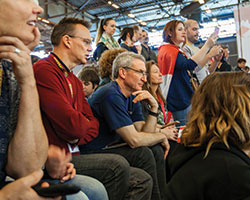 Dealing with details
Dealing with details
Wednesday, Feb. 3
Hotel Campanile, Roissy en France
The teams and their supporters are all staying in Hotel Campanile, near the Parc des Expositions de Paris-Nord Villepinte in suburban Paris. The lobby, restaurant and bar are abuzz with languages from around the world.
After wrapping up practices in Lille, the Canadians drive to Paris along with eight extra-large plastic bins full of ingredients and equipment brought from Edmonton, including the silicone molds Holehouse made for some of the 150 parts of his sculpture, a depiction of Canada's unofficial national sport, hockey. They store the bins and the baking racks that they have borrowed from one of the tradeshow suppliers in their tiny hotel rooms.
Dumonceaux, the team's Viennoiserie (breads similar to pastry) and savoury bakery expert, pulls his racks out into the fourth floor hallway along with two bins. They're filled with dozens of bags of ingredients. Back home he made pages of labels: cocoa, black sesame seeds, fleur de sel, ground hazelnuts and more. He puts each ingredient into a small plastic container, affixes labels and arranges them carefully on the rack, in the order he'll need to use them.
"This will save minutes," he says. "And every minute counts."
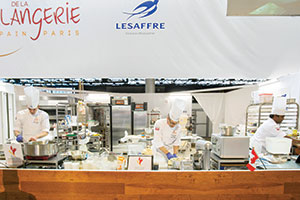
The big day
Sunday, Feb. 7
Parc des Expositions de Paris-nord Villepinte, Paris
After being given two hours to set up their competition kitchen the night before, the members of Team Canada are up at 4 a.m. to catch the bus from the hotel to the convention centre, site of the event, along with the competitors from China, Turkey and the hometown favourites, France.
The massive centre is the site of Europain, a trade show of bread, chocolate and confections attended by more than 60,000 people from all over Europe. Four fully appointed kitchens are set up in one corner, open for spectators and judges to see. The teams have eight hours starting promptly at 5 a.m.
Team Canada's strategy is to move quickly at the start of the competition so they can spend more time assembling the sculpture and pastries, says Folkers, who watches from the stands, his iPad on his lap, its timer counting down the eight hours. The judges pace in front of the kitchens, stopping to examine ingredients, watch technique and observe factors like cleanliness and teamwork.
The stands in front of Team Canada's kitchen are filled with supporters: Folkers' wife, Dumonceaux's wife and two sons, Holehouse's mother, and a couple of dozen culinary students from Vancouver Island University on a tour of France. Peter Poole and his wife Nan, owners of Banff's Wild Flour bakery, are here too.
"The great irony is to have Canada, this little former colony that some people think only makes bannock and muffins, coming here and making better baguettes than the French," says Poole. "We know there's a business model to support this [artisan baking] and we've got the schools to train people for it, so it's an exciting time for someone who wants to create a wonderful livelihood as a baker and contribute to the community."
Focused on their work, Dumonceaux, Holehouse and Mariathas manoeuvre skillfully through the kitchen, gliding around each other like veteran hockey teammates.
While each prepares his own pieces for the competition, they also work on the components of the sandwiches, curing salmon in salt, gin and spices, cooking pork shoulder in the pressure cooker, sautéing mushrooms and garlic. Some of the teams treat the sandwiches as an afterthought because they're only worth 10 per cent of the overall mark, says Folkers. But Team Canada sees them as valuable bonus points.
Brian Sisson, vice-president of operations at Ace Bakery, the team's sponsor, leads the crowd in a few bars of O Canada in his booming voice, before switching to another anthem. "Oh the good ol' hockey game, it's the best game you can name, and the best game you can name, is the good ol' hockey game."
As the kitchen, and the competition, heats up, Team Canada struggles to finish on time. At the eight-hour mark, China and France are done. The Canadians are waiting for their bread to come out of the oven and are still putting the finishing touches on sandwiches. After eight hours and 18 minutes, they step away from the kitchen.
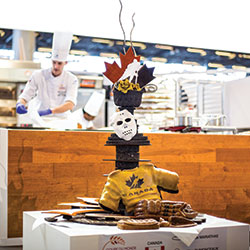
"Were we good enough?"
Monday, Feb. 8
Hotel Campanile, Roissy en France
Team Canada takes a penalty for exceeding the time limit.
"I knew I was late but I wasn't going to rush it either," says Mariathas, whose baguettes didn't go into the oven until minutes before the eight-hour time limit.
"The points you lose for time are so minimal, I knew I would make up for it in taste."
Holehouse ran into trouble too. Small ovens meant it took him longer - almost five hours - to bake all the pieces of his sculpture. His biggest stressor was the fear that his showpiece would collapse as it had in Argentina mere minutes after judging. "I would have liked to have been structurally daring but you're taking a huge risk. I didn't have the option to play around."
A Reactine pill kept Dumonceaux's allergies in check but he ended up with flour he wasn't expecting. It contained ascorbic acid, which caused his croissants to shrink in length during the rising process. But the hardest thing for him was the low workbench set up for all the pastry chefs. "My body was just aching after eight hours," he says.
In all, the three bakers were pleased with their results. Holehouse's showpiece held together; the pastries were beautiful despite the challenging flour; and the baguettes and bread were among Mariathas's best, he says.
Relieved and exhausted, they now nervously wait while the final three teams compete before the results are announced.
"The challenge with competitions is that there are always things that don't go as expected," says Dumonceaux. "The question is, on this day, were we good enough?"
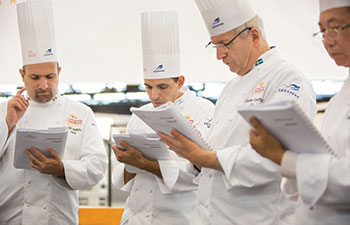
And the winner is …
Tuesday, Feb. 9
Parc des Expositions
After three days of competition, the 12 teams and their supporters gather in front of the empty kitchens at the convention centre for the announcement of the results.
Third place: France. Second place: Taiwan. First place: South Korea.
The Canadians are disappointed but not surprised - they competed against the best bakers in the world. Unofficially, they are told they placed seventh out of 12.
"Of course it's not the outcome we were hoping for," admits Holehouse, but he and the other members say they are proud of their work.
"It was totally worth it," he says. "It's been such an amazing experience. It has bettered me in my craft but also in life skills like how to deal with adversity, how to be flexible and deal with pressure, how to be organized - these are all skills I can bring back to my students."
"To me," says Dumonceaux, "the biggest thing is I hope to inspire young bakers to consider the opportunity to compete for their country. People have always thought about Canadians and hockey, not about Canadians and baking. Now they will."
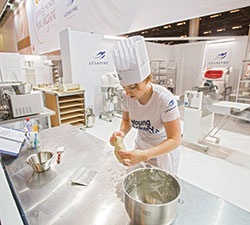 Young and Hopeful
Young and Hopeful
Elien de Herdt has only been baking professionally for two years, but she's already representing her country on the international stage.
As the junior member of Baking Team Canada, De Herdt (Baking '14, far right) competed last spring at the Coupe Louis Lesaffre in Buenos Aires, the event at which her teammates qualified to compete in the Coupe du Monde de la Boulangerie in Paris.
In France, she competes as a Young Hopeful in an affiliated event that tests the skills of five young bakers, each representing one region of the world. De Herdt represented all of North and South America.
In the months before the event, the 20-year-old baker survived on little sleep, working from 1 to 9 a.m. at Edmonton's Dutch Delicious bakery and practicing afternoons and evenings in the NAIT bakery with coach, mentor and baking instructor Clayton Folkers. "It's like having two jobs," she said during a practice. "But it'll be worth it."
For the competition, each of the Young Hopefuls has to make four sets of 25 items - two sets savoury and two sweet - for a children's picnic brunch. True to her horticultural roots (her parents own a greenhouse in Barrhead; her grandparents had a greenhouse in her native Belgium), De Herdt bakes a garden, shaping flowers out of croissant dough and embedding them in tiny terra cotta pots filled with brioche dough. She makes little sourdough buns filled with goat cheese and candied ham, decorating them to look like ladybugs and turtles. Her father, Koen De Herdt, surprised her by showing up in Paris to watch her compete.
"She's worked really hard for this," he says. "Her sister told me last week she went to work, slept for 20 minutes and then went to NAIT to practice."
Coach Folkers watches her progress, offering the occasional suggestion or support. "She doesn't get too excited under pressure," he says. "She's pretty steady all the time."
She finishes within the four-hour time limit and displays her garden for the official judges and the informal judges - a group of French schoolchildren.
The judges choose the Dutch competitor, Rianne Kuijntjes as the winner. The remaining four young hopefuls, from Spain, Mauritius, Australia and Canada, aren't ranked but are told their creations were all impressive and very close in points.
De Herdt is disappointed but also thrilled by the excitement of the competition and the incredible opportunity to meet renowned bakers from around the world. "Now I have these connections to people in Ireland, in Taiwan, in Japan," she says.
One day she might even see them here again. Unlike her Baking Team Canada colleagues and mentors, who can only compete once in the team event, De Herdt will be able to use her experience and connections as a Young Hopeful to potentially return one day to compete again.
"It's been an amazing experience."